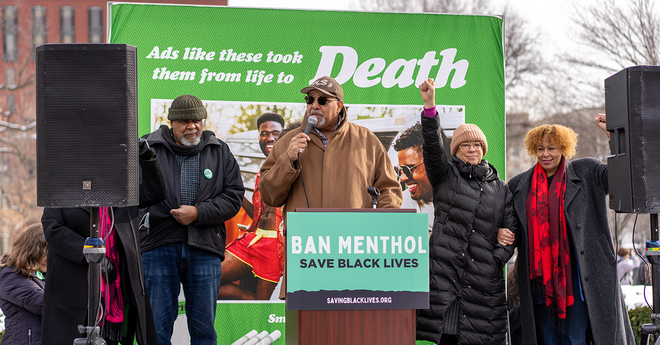A growing problem: Examining a decade of menthol smoking rates
Menthol is slowing the decline of cigarette smoking in the U.S. Data from 2004 to 2010 shows that, while non-menthol cigarette use declined, menthol smoking rates remained constant and even grew among some groups. On top of that, youth smokers were the age group most likely to smoke menthols.
To learn more about these patterns, investigators at the Schroeder Institute® for Tobacco Research and Policy Studies collaborated with other researchers to review menthol smoking data from 2004 to 2014 to identify what changed and stayed the same in recent years. The findings, published in Tobacco Control, show how menthol is thwarting progress to decrease smoking rates in new and familiar ways.
Youth smokers still smoke menthols at higher rates, with the youngest smokers the most likely to use them. In 2014, youth and young adult smokers were more likely to smoke menthol cigarettes, which are easier to smoke and harder to quit than non-menthol cigarettes.
Overall, the proportion of smokers using menthols increased from 35 percent (2008 to 2010), to 39 percent (2012 to 2014). While certain groups—youth, women, and African-Americans, who have long been targeted by tobacco industry marketing—continue to smoke menthols at higher rates, research shows that they have become increasingly more popular among White, Asian and Hispanic smokers since 2010.
Another notable increase: the number of smokers who use cigars or smokeless tobacco at the same time as menthols grew from 2004 to 2014. Researchers say the link could be due to the “pervasiveness” of menthol and other characterizing flavors in the products. Little cigars and cigarillos, which also contain flavoring designed to appeal to youth, are sold in smaller quantities of singles and five-packs. That could make them a cheaper alternative or a substitute for candy- and fruit-flavored cigarettes, which were banned in 2009.
Researchers also note that tobacco companies are fueling menthol’s increased market share. They cite the 2015 merger of Lorillard and Reynolds American Tobacco Companies and the resulting “strategic push to accelerate the retail impact of the Newport brand,” the country’s top menthol brand. Additionally, Philip Morris rolled out new menthol brands, such as Marlboro Midnight.
“Given that cigarettes are the dominant product used in the country and the most harmful, there is tremendous urgency to enact large-scale efforts to limit the impact of menthol cigarettes on public health,” said Andrea Villanti, director for Regulatory Science and Policy at the Schroeder Institute.
Truth Initiative® has repeatedly called on the U.S. Food and Drug Administration to ban menthol, a move that would have saved more than 320,000 lives if it went into effect in 2011.
For more on menthol, get the truth about its devastating effects from our fact sheet.
Key takeaways
Youth and young adult smokers were more likely to smoke menthol cigarettes than non-menthol cigarettes in 2014
The proportion of smokers using menthols increased from 35 percent during 2008 to 2010, to 39 percent during 2012 to 2014
Since 2010, menthols have become more popular among White, Asian and Hispanic smokers
The number of smokers who use cigars or smokeless tobacco at the same time as menthols, grew from 2004 to 2014
More in traditional tobacco products
Want support quitting? Join EX Program
By clicking JOIN, you agree to the Terms, Text Message Terms and Privacy Policy.
Msg&Data rates may apply; msgs are automated.



